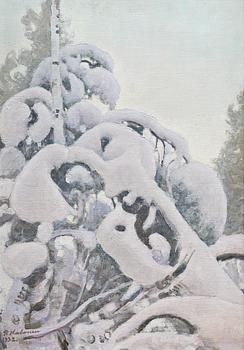Pekka Halonen (1865-1933)
The artist Pekka Halonen is closely associated with Finland, known for his realistic and simple depictions of the Finnish people and nature. Halonen was born in 1865 in Lapinlahti and belonged to a large farming family with several talented artists and musicians among its members. In 1890, he received a scholarship that enabled him to travel to Paris and study at the Académie Julian. Halonen continued his studies under Paul Gauguin at the Académie Colarossi in Italy. Similar to several contemporary Finnish artists like Aleksi Gallen-Kallela, Halonen eventually returned to his homeland to explore subjects in the Finnish wilderness.
In the early stages of his career, Halonen primarily worked in a French impressionist style, but later his painting evolved towards a more monumental approach with subdued colors, often depicting themes from Finnish rural life such as "Vägbrytare i Karelen" from year 1900. Colors dominated Halonen's work; he was a virtuoso in coloration. The Finnish nature played a central role in Halonen's art, and in his numerous landscape paintings, one can also discern clear influences from symbolism and Japonism.








































